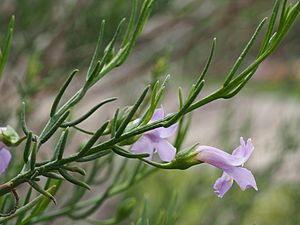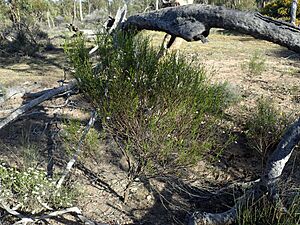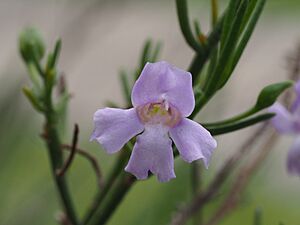Drummond's eremophila facts for kids
Quick facts for kids Drummond's eremophila |
|
|---|---|
 |
|
| Eremophila drummondii growing in Kings Park | |
| Scientific classification | |
| Genus: |
Eremophila (plant)
|
| Species: |
drummondii
|
| Synonyms | |
Eremophila drummondii, also known as Drummond's eremophila, is a beautiful flowering plant. It belongs to the figwort family. This plant grows only in the southwest part of Western Australia.
It is a type of shrub that can look different depending on where it grows. It often has sticky branches and leaves. Its leaves are long and thin. You can see its lovely mauve or purple flowers mostly in spring.

Contents
What Does Drummond's Eremophila Look Like?
Drummond's eremophila can be a low, spreading plant. It might be less than 0.3 meters (about 1 foot) tall. Other times, it grows straight up to 3 meters (about 10 feet) high.
Its branches and leaves are usually shiny and sticky. The branches also have small grooves under where the leaves grow. The leaves are long and narrow. They are usually between 10 and 45 millimeters (about 0.4 to 1.8 inches) long. They are 1 to 6 millimeters (about 0.04 to 0.24 inches) wide. The leaves are smooth and do not have hairs.
The Flowers and Fruits
The flowers grow either alone or in small groups of up to three. They appear where the leaves meet the stem. Each flower has a smooth, shiny stalk that is 6 to 30 millimeters (about 0.2 to 1.2 inches) long.
There are five green, shiny sepals that protect the flower bud. These are shaped like eggs or spears. They are about 3.5 to 6 millimeters (about 0.14 to 0.24 inches) long. The petals are joined together at the bottom to form a tube. This tube is 12 to 25 millimeters (about 0.5 to 1 inch) long.
The outside of the petals can be blue, mauve, or purple. The inside of the tube is white. The outside of the flower tube is shiny and smooth. But the inside of the tube is covered with long, soft hairs. The four parts that make pollen (stamens) are hidden inside the flower tube.
You can see these flowers during many months of the year. However, they bloom most often in August and September. After the flowers, the plant grows fruits. These fruits are oval or oblong. They are smooth, shiny, and sticky. They measure about 4.5 to 7.5 millimeters (about 0.18 to 0.3 inches) long.
Where Does It Grow?
Drummond's eremophila is common in many areas of Western Australia. You can find it between York and Southern Cross. It grows in different types of soil. It is often found in woodlands where eucalyptus and acacia trees grow.
Growing Drummond's Eremophila in Your Garden
This plant is a great choice for gardens. The low-growing types are very neat and produce many flowers in spring. Their shiny leaves look nice with the flowers.
You can grow these plants from cuttings. They can grow in many different kinds of soil. They like to be in full sun. Once they are settled, they don't need much water. They can also handle frost well.
Conservation Status
The Western Australian Government's Department of Parks and Wildlife says that Eremophila drummondii is "not threatened." This means it is not in danger of disappearing.


